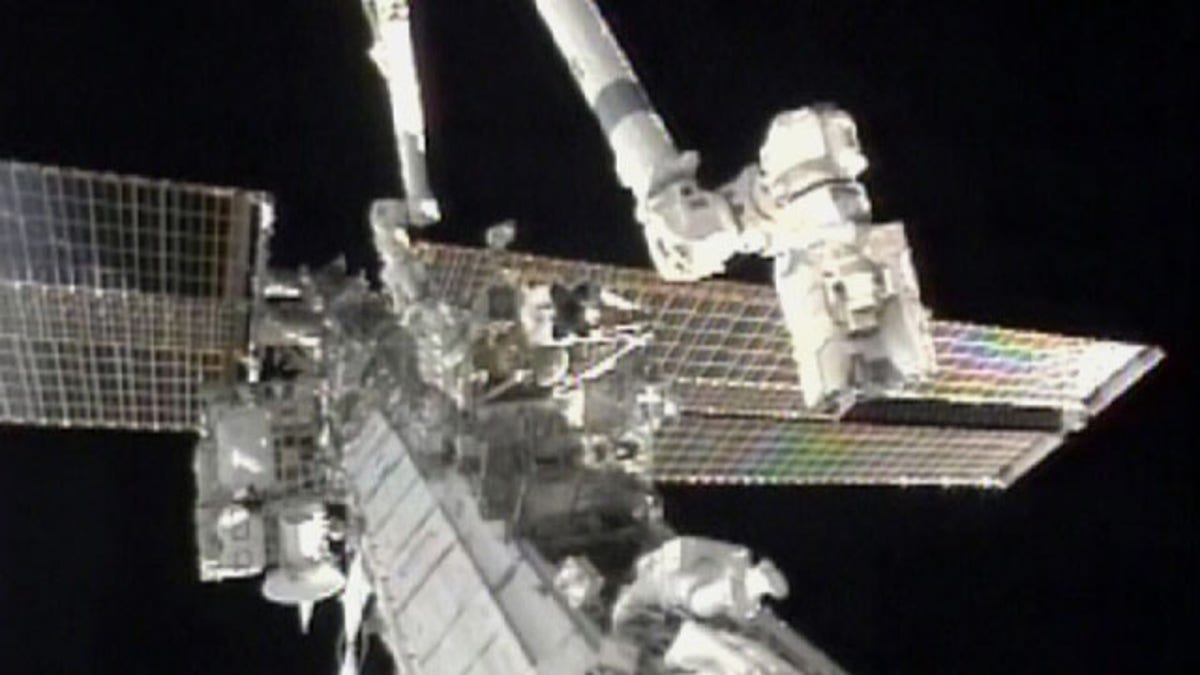
Aug. 7: In this image taken from video and made available by NASA, astronauts Douglas Wheelock, top, and Tracy Caldwell Dyson work on the International Space Station to restore a crucial cooling system. (AP/NASA)
Astronauts aboard the International Space Station are gearing up to continue vital spacecraft repairs Wednesday for the second in a series of tricky spacewalks to replace a faulty coolant pump.
American astronauts Douglas Wheelock and Tracy Caldwell Dyson plan to remove the failed pump during a six-hour spacewalk. The spacewalk has been dramatically replanned after weekend repair attempts were stalled by a jammed hose and leaking ammonia coolant. [Graphic: Space Station's Cooling System Problem Explained
Wednesday's spacewalk is set to begin just after 7 a.m. ET (1100 GMT). If all goes well, the astronauts will finally be able to replace the pump on the station's starboard truss in an extra spacewalk scheduled for Sunday.
Tricky repair spacewalks
The upcoming spacewalk follows an eight-hour, three-minute excursion Saturday that is the sixth longest in history, but fell short of its intended goal of removing the oven-sized pump module.
First, one of four ammonia coolant hoses was jammed. Then, after Wheelock used a hammer to bang it free, the hose leaked a substantial amount of ammonia – so much that the astronaut called it a "snowstorm."
NASA mission planners on Earth regrouped after the Saturday spacewalk to alter plans for what will now require a total of at least three repair spacewalks to mend.
Space station managers have choreographed a series of procedures for Wheelock and Caldwell Dyson to perform at the start of Wednesday's spacewalk that are "designed to greatly reduce, or eliminate the possibility of ammonia leaking from the final fluid connector – called M3 – when it is demated to set the stage for the failed pump to be removed from the truss," NASA officials said in a statement.
The plan requires the astronauts to close off separate hoses of ammonia coolant on the station's starboard truss, effectively isolating ammonia upstream in the system from the final connector.
This should prevent further leakage during the installation of the new pump. Mission planners have also been vigilant in taking precautions to avoid contamination from the ammonia.
Spacewalk on tap
Overnight, ground controllers activated a pressure regulator valve that lowered the overall pressure in the plumbing for the inactive cooling loop. This will help Wheelock and Caldwell Dyson close two valves needed to isolate the ammonia, and will also facilitate with the reconnection of the fluid lines once the new pump is installed.
The astronauts will use a tool to vent any residual ammonia from the failed pump module before the final hose is disconnected.
Wheelock and Caldwell Dyson will also configure the coolant lines and valves before disconnecting electrical data connections from the old pump and parking it on a stowage bracket on the space station's Mobile Base System.
The installation of the new pump is targeted for the third spacewalk, which is expected to occur no earlier than Sunday.
The station's systems remain in good condition operating on the second of two cooling loops available for the complex.
Wheelock and Caldwell Dyson will move into the Quest airlock later today to begin their overnight "campout" to reduce the nitrogen in their bloodstreams.
Space pump failure
The ammonia pump failed July 31, knocking out half of the space station's cooling system and forcing astronauts to turn off some experiments and systems, as well as leave others without backups, in order to prevent the station from overheating. A tripped circuit breaker, likely caused by a power spike, caused the malfunction, station managers have said.
The International Space Station uses liquid ammonia to cool its onboard systems by transporting waste heat to a network of radiators mounted to its main truss. There are two main cooling system loops – Loop A and Loop B. The failed pump is in Loop A, while the other cooling loop remains operational.
The failed ammonia pump is located on the station's right side truss and will be replaced with one of four spare pumps stored at the orbiting lab.
Each pump weighs 780 pounds (353 kg) and is 5 1/2 feet long (1.6 meters) by 4 feet wide (1.2 meters). They are about 3 feet (almost 1 meter) tall.




















